

Slash and Burn Agriculture. Slash and burn agriculture is the process of cutting down the vegetation in a particular plot of land, setting fire to the remaining foliage, and using the ashes to provide nutrients to the soil for use of planting food crops.

The cleared area following slash and burn, also known as swidden, is used for a relatively short period of time, and then left alone for a longer period of time so that vegetation can grow again. For this reason, this type of agriculture is also known as shifting cultivation. National Geographic. Ocean overfishing is simply the taking of wildlife from the sea at rates too high for fished species to replace themselves.
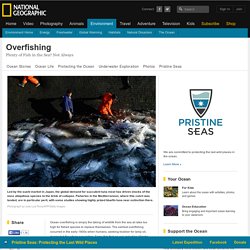
The earliest overfishing occurred in the early 1800s when humans, seeking blubber for lamp oil, decimated the whale population. Some fish that we eat, including Atlantic cod and herring and California's sardines, were also harvested to the brink of extinction by the mid-1900s. Highly disruptive to the food chain, these isolated, regional depletions became global and catastrophic by the late 20th century. When It Started Marine scientists know when widespread overfishing of the seas began. In the mid-20th century, international efforts to increase the availability and affordability of protein-rich foods led to concerted government efforts to increase fishing capacity. Ending Overfishing. Japan Whaling Assoc. -Q&A- Japan Whaling Assoc. -Q&A-
Whaling. 10 Things You Can Do to Save the Ocean. 1.
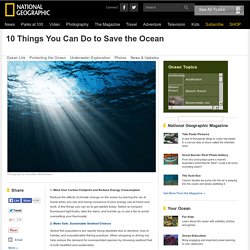
Mind Your Carbon Footprint and Reduce Energy Consumption Reduce the effects of climate change on the ocean by leaving the car at home when you can and being conscious of your energy use at home and work. A few things you can do to get started today: Switch to compact fluorescent light bulbs, take the stairs, and bundle up or use a fan to avoid oversetting your thermostat. 2. Make Safe, Sustainable Seafood Choices Global fish populations are rapidly being depleted due to demand, loss of habitat, and unsustainable fishing practices. 3.
Plastics that end up as ocean debris contribute to habitat destruction and entangle and kill tens of thousands of marine animals each year. 4. Whether you enjoy diving, surfing, or relaxing on the beach, always clean up after yourself. 10 Things You Can Do to Save the Ocean. Slash and Burn Agriculture. Oil spill. Oil spills penetrate into the structure of the plumage of birds and the fur of mammals, reducing its insulating ability, and making them more vulnerable to temperature fluctuations and much less buoyant in the water.
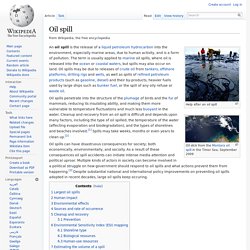
Cleanup and recovery from an oil spill is difficult and depends upon many factors, including the type of oil spilled, the temperature of the water (affecting evaporation and biodegradation), and the types of shorelines and beaches involved.[1] Spills may take weeks, months or even years to clean up.[2] Oil spills can have disastruous consequences for society; both economically, environmentally, and socially.
As a result of these consequences oil spill accidents can initiate intense media attention and political uproar. Largest oil spills[edit] Oil spills at sea are generally much more damaging than those on land, since they can spread for hundreds of nautical miles in a thin oil slick which can cover beaches with a thin coating of oil. Human impact[edit] Threats ti ocean national geographic. Blob fish. The blobfish recently took home honors as the “World’s Ugliest Animal.”

But how ugly is it, really? When you consider that the photo that people voted for was of a decompressed specimen that only barely resembles the living animal, it hardly seems fair to judge. The most famous photo of a blobfish — and the one used for the contest — is of Mr. Blobby, a specimen collected in 2003 northwest of New Zealand. The fish sports a big floppy frown, a bulbous nose and has a yellow parasite hanging from its mouth.
Mr. According to the Australian Museum in Sydney, which houses Mr. Alive and at proper pressure, P. marcidus probably doesn’t have Mr. Drawings of blobfish show them as much more fishlike. Alan Riverstone McCulloch/Wikimedia Commons “Species of Psychrolutes have very weak, barely ossified bones, so they look bloblike even in life,” says ichthyologist Ronald Fricke of the Staatliches Museum in Stuttgart. An underwater rover captured a photo of the plump blobfish. 10 Endangered Ocean Species and Marine Animals. Threatened Marine Species Photos. 13 Threatened Animals Of The Ocean (PHOTOS) Threatened Marine Species Photos. Endangered Species International. Deep-Sea Creature Photos. Pictures of Endangered Sea Creatures - Endangered Sea Life Pictures.
Endangered09-manatees_24059_600x450.jpg (JPEG Image, 600 × 450 pixels) Wildlife destruction to animals. Wildlife emergencies Contact the department ( ) to report wildlife emergencies relating to: cassowaries crocodiles in Queensland incidents where a person has been bitten or scratched by a bat or has had bat saliva or neural tissue come into contact with their eyes or other mucous membrane surfaces (e.g. inside the mouth) To report all other wildlife emergencies such as sick, injured or orphaned animals, marine animal strikes or strandings, contact the RSPCA Qld ( ).
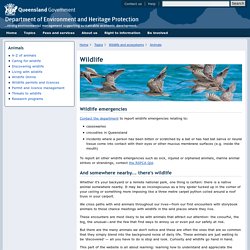
And somewhere nearby... there's wildlife Whether it’s your backyard or a remote national park, one thing is certain: there is a native animal somewhere nearby. We cross paths with wild animals throughout our lives—from our first encounters with storybook animals to those chance meetings with wildlife in the wild places where they live. Endangered Oceans lesson plan. Endangered Oceans Activities The ocean covers more than seventy percent of the surface of the earth.

Our oceans are in trouble as the result of pollution and over fishing. Many species of marine wildlife are in danger of extinction, and our coral reefs, wetlands, and kelp forests are disappearing. Dolphin Information - Dolphin Facts and Information. Dolphin Habitat and Distribution Dolphins live in saltwater but they can also live in freshwater locations.

Only a handful of the species though are known to thrive in freshwater regions. Endangered Animal Printouts. Advertisement.
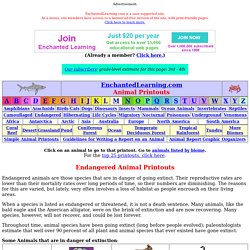
EnchantedLearning.com is a user-supported site. As a bonus, site members have access to a banner-ad-free version of the site, with print-friendly pages.Click here to learn more. (Already a member? Click here.) Hector's Dolphin.